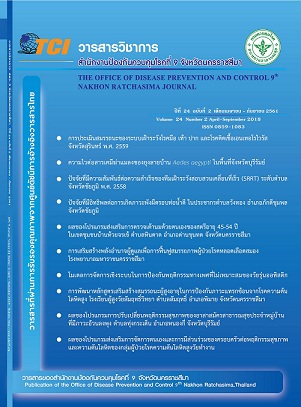A Systematic Management Model for Inappropriate Sexual Behaviors Preventing of Adolescents with Autism Spectrum Disorder
Keywords:
A systematic management model, Inappropriate sexual behaviors, Adolescents with autism spectrum disorderAbstract
This qualitative research was to develop systematic management model for inappropriate sexual
behavior preventing of adolescents with autism spectrum disorder. Data were collected from 24 family
members or relatives of autistic persons and related documents. Semi-structured interview was used
for focus group and in-depth interview. The important points were as follows: knowing that the
persons with autism had changed to adolescence with physical, mental, emotional and social change
as a common teenager and they also had shown challenging and improper behaviors because
of their sexual hormonal change and lacking of knowledge about it such as masturbating, being
naked in the public etc, their parents and guardians were stressed and worried about how to take care
of them in school and work. However, the teenagers with autism need to develop themselves properly
as a base to live a life. Helping them to behave themselves properly and change improper manners
is the role of their parents and guardians. The model of systematic management for inappropriate
sexual behavior preventing of adolescents with autism spectrum disorder is very useful for the parents
and guardians of the persons with autism. It can be applied to use in their real life. With their
development and a positive attitude of the people in the society, the teenagers with autism can live
normally without a burden to their family, society and nation
References
Publication; 2004.
2. ศิริกุล อิศรานุรักษ์. สุขภาพเด็กวัยรุ่นและการดูแล. 2557 สืบค้นเมื่อ 29 สิงหาคม 2560, จาก http://
www.elib-online.com /doctors/sexed_teenage03.html.
3. พนม เกตุมาน. ตำราจิตเวชเด็กและวัยรุ่น. กรุงเทพฯ: บิยอนด์ อินเตอร์ไพรซ์; 2550 : 141-159.
4. เพ็ญแข ลิ่มศิลา. คู่มือฝึกและดูแลเด็กออทิสติกสำหรับผู้ปกครอง. กรุงเทพฯ : คุรุสภาลาดพร้าว, 2545.
5. American Psychiatric Association (APA). Diagnostic and statistical manual of mental disorder, 4th,
text rev. Washington DC : Author; 2000.
6. เมธิศา พงษ์ศักดิ์ศรี. ภาวะออทิสติกและผลกระทบต่อสังคมรวมทั้งการมีส่วนร่วมในการสร้างเครือข่าย
ออทิสติก. เชียงใหม่; ภาควิชากิจกรรมบำบัดคณะเทคนิคการแพทย์มหาวิทยาลัยเชียงใหม่; 2554.
7. The National Autistic Society. Autism and Independence. London UK, 2007.
8. Haracopos D, Pedersen L. Sexuality and autism: Danish report. United Kingdom: Society for
the Autistically Handicapped, 1992.
9. คมชัดลึก. 4 กลไกออทิสติกโรดแม็พ เพิ่มที่ยืน “ออทิสติก” ในสังคม. 2560 สืบค้นเมื่อ 29 สิงหาคม
2560, จาก http://www. komchadluek.net/news/edu-health/295390.
10. ฐานเศรษฐกิจ. กรมสุขภาพจิตเผยเด็กไทยป่วยโรคออทิสติก 3 แสนคน เร่งวิจัยหา“ยีนต้นเหตุ”. 2560
สืบค้นเมื่อ 29 สิงหาคม 2560, จาก http://www.thansettakij.com/content/183997.
11. ชูศักดิ์ จันทยานนท์. เผยเด็กออทิสติกกว่า 3 แสนนอกระบบ แนะวิธีพ่อแม่ดูแล , 29 สิงหาคม 2560.
สืบค้นจาก https://www.hfocus.org/content/2013/03/2698.
12. Gibb S. Human resource development: processes, practices and perspectives. 3rd ed. Basingstoke:
Palgrave MacMillan ; 2011: 332.
13. สำนักงานคณะกรรมการพัฒนาเศรษฐกิจและสังคมแห่งชาติ. แผนพัฒนาเศรษฐกิจและสังคมแห่งชาติ
ฉบับที่ 11, 12พ.ศ. 2555-2564. 2555, 2560 สืบค้นเมื่อ 29 สิงหาคม 2560, จาก http://
www2.oae.go.th/EVA/download/Plan/SummaryPlan11_thai.pdf.
14. Driscoll MP. Psychology of learning for instruction. 2nd ed. Boston, MA: Allyn & Bacon
Publishers; 2000.
15. สำนักงานปลัดกระทรวงการพัฒนาสังคมและความมั่นคงของมนุษย์. สถิติการจดทะเบียนคนพิการ
ในประเทศไทย. 2556 สืบค้นเมื่อ 29 สิงหาคม 2560, จาก https://www.m-society.go.th/article_
attach/10429/15326.pdf.
16. Patton MQ. Qualitative evaluation and research methods. 2nd ed. London: Sage, 1990.
17. อรุณี อ่อนสวัสดิ์. ระเบียบวิธีวิจัย. พิมพ์ครั้งที่ 3. ภาควิชาการศึกษา คณะศึกษาศาสตร์ มหาวิทยาลัย
นเรศวร; 2551: 282.
18. Strauss A, Corbin J. Basics of qualitative research: Grounded theory procedures and techniques.
Newbury Park CA: Sage, 1990.
19. กรมส่งเสริมและพัฒนาคุณภาพชีวิตคนพิการ. พระราชบัญญัติส่งเสริมและพัฒนาคุณภาพชีวิตคนพิการ
พ.ศ. 2550. สืบค้นเมื่อ 29 สิงหาคม 2560, จาก http://www.dep.go.th.
20. สุพัตรา วงศ์วิเศษ, แอนดรา ดี, นฤมล ทวีพันธ์, วีรมลล์ โล้เจริญรัตน์. การใช้ Positive Behavior Support,
Sensory Integration, and Relaxation ในการปรับพฤติกรรมและลดพฤติกรรมที่ไม่พึงประสงค์
สำหรับนักเรียนออทิสติกที่มีระดับค่อนข้างรุนแรง.บทความวิจัยนำเสนอในการประชุมทางวิชาการ
มหาวิทยาลัยเกษตรศาสตร์ ครั้งที่ 45. 30 มกราคม - 2 กุมภาพันธ์ 2550.
21. สุภาพร ชินชัย. เอกสารประกอบคำบรรยายกิจกรรมบำบัด. โครงการฝึกอบรมครูและ บุคคลากรทาง
การศึกษาพิเศษ : โรงเรียนสาธิตแห่งมหาวิทยาลัยเกษตรศาสตร์. ศูนย์วิจัยและพัฒนาการศึกษา.
กรุงเทพฯ: มหาวิทยาลัยเกษตรศาสตร์; 2547.
22. Autism South Australia. Information Sheet 1 Relaxation. 2004 สืบค้นเมื่อ 29สิงหาคม 2560,
จาก http://www.autismsa.org.au.
23. Jackson L, Panyan MV. Positive behavioral support in the classroom: principles and practices.
Baltimore: Paul H. Brookes; 2002.
24. เพ็ญแข ลิ่มศิลา. ออทิสซึ่มในประเทศไทยจากตำราสู่ประสบการณ์ ในเอกสารประกอบบรรยายพิเศษ
การประชุมระดับชาติเรื่อง ครู หมอ พ่อแม่: มติการพัฒนาศักยภาพของบุคคลออทิสติก. กรุงเทพฯ:
มหาวิทยาลัยเกษตรศาสตร์; 2545.
25. Bronfenbrenner U. Toward an experimental ecology of human development. American Psychologist
1977 ; 32: 515-31.
26. Pretty J, Peacock J, Hine R, Sellens M, South N, Griffin M. Green Exercise in the UK Countryside:
Effects on Health and Psychological Well-Being, and Implications for Policy and Planning.
Journal of Environmental Planning and Management 2007; 50(2) : 211–231.
27. สมโภชน์ เอี่ยมสุภาษิต. ทฤษฎีและเทคนิคการปรับพฤติกรรม. กรุงเทพฯ: สำนักพิมพ์แห่งจุฬาลงกรณ์
มหาวิทยาลัย ; 2549.
28. Bandura A. Social Foundations of Thought and Action: A Social Cognitive Theory. New York:
Prentice-Hall; 1986.
29. Skinner BF. Science and Human Behavior. New York: MacMillan ; 1953.
30. Charles LR. Increasing Prosocial Behaviors in Young Children : A Study of Training Generalization
and Maintenance Effects. Dissertation Abstracts International 1981;4(1): 5310.
31. Allen KE, Keith DT. A Behavior Modification Classroom for Handicap Children with Problem
Behaviors. Exception Children 1970;37(3): 119–27.
32. จุฑามณี ตระกูลมุทุตา. การพัฒนาทรัพยากรมนุษย์ในองค์การ. สงขลา: ภาควิชารัฐประศาสนศาสตร์
คณะวิทยาการจัดการ มหาวิทยาลัยสงขลานครินทร์, สงขลา;2544.
33. วันทนีย์ เรียงไรสวัสดิ์. ผลการใช้ระบบการแลกเปลี่ยนภาพเพื่อการสื่อสารในการพัฒนาทักษะการสื่อสาร
สำหรับนักเรียนออทิสติกระดับปฐมวัย โรงเรียนกาวิละอนุกูล จังหวัดเชียงใหม่. 2552 สืบค้นเมื่อ
29 สิงหาคม 2560, จาก https://www.kroobannok.com/board_ view.php?b_id=29490.
34. Bogdashina O. Sensory Perceptual Issue in Autism and Asperger Syndrome. New York:
Jessica Kingsley; 2003.
35. หรรษา องคสิงห์. การปรับพฤติกรรมการรอคอยของเด็กออทิสติกโดยใช้กิจกรรมการเล่น. การค้นคว้า
แบบอิสระศึกษาศาสตรมหาบัณฑิตสาขาวิชาการศึกษาพิเศษบัณฑิตวิทยาลัยมหาวิทยาลัยเชียงใหม่,
เชียงใหม่; 2554.
36. วรรณภา บุญลาโภ. การศึกษาทักษะทางสังคมของนักเรียนชั้นประถมศึกษาปีที่ 1 ที่มีภาวะออทิสซึม
จากการสอนโดยวีดิทัศน์แสดงต้นแบบพฤติกรรม (Video Modeling) ร่วมกับสถานการณ์จำลอง.
วิทยานิพนธ์การศึกษามหาบัณฑิตสาขาวิชาการศึกษาพิเศษบัณฑิตวิทยาลัยมหาวิทยาลัยศรีนครินทรวิโรฒ,
นครปฐม; 2556.
37. พัสมณฑ์ คุ้มทวีพร. การพยาบาลผู้ป่วยมะเร็งการป้องกันและการดูแลผู้ป่วย. กรุงเทพมหานคร: ฮายาบุสะ
กราฟฟิก; 2553.
38. Chopik JW. Associations among relational values, support, health, and well-being across the adult
lifespan. Personal Relationships 2017;24(2): 408.

Downloads
Published
How to Cite
Issue
Section
License
บทความที่ลงพิมพ์ในวารสารวิชาการสำนักงานป้องกันควบคุมโรคที่ 9 จังหวัดนครราชสีมา ถือว่าเป็น
ลิขสิทธิ์ สำนักงานป้องกันควบคุมโรคที่ 9 จังหวัดนครราชสีมา



